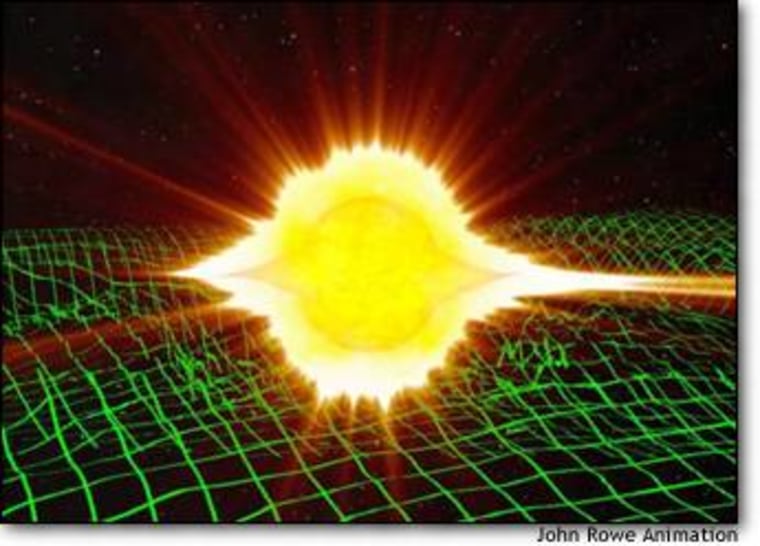Astronomers have discovered two neutron stars that are orbiting each other once every 2.4 hours and spiraling inward toward an eventual dramatic collision. The finding suggests that such intense events are far more common than was thought. If the work is correct, astronomers could by the end of the decade detect elusive “gravitational waves,” which should be spawned in the final seconds prior to the mighty mergers.

SCIENTISTS CALL these emissions — which have yet to be directly detected — the theoretical “death chirp” of a neutron-star pair. Similar emissions are expected in black hole mergers.
Detecting gravitational radiation, as it is also called, would be an important confirmation of Einstein’s theory of general relativity.
A neutron star is already a stellar corpse. It is formed when an aged star explodes and as much material as what’s in our sun collapses into a region the size of a city. A teaspoonful, brought to Earth, would weigh a billion tons or so. Neutron stars are stuffed almost entirely with neutrons, subatomic particles that can huddle extremely close together.
Only six neutron-star pairs, called binary systems, are now known.
Previous studies of other pairs have shown that these exotic dance teams spiral toward each other and must eventually crash and unite, possibly becoming a black hole. Einstein theorized that space-warping gravitational waves — caused by two accelerated masses in orbit — are the reason for this orbital decay.
But the gravitational radiation generated during orbital decay is nowhere near as intense, or detectable, as what a merger would generate.
Another pair of known neutron stars is destined for calamity in 320 million years, forming the limited basis for estimates of how often the events occur.
The newfound duo will hit in a mere 85 million years. That’s forever on a human time scale, but there was an interesting twist in the observations, made by an international team of astronomers.

MANY MORE OUT THERE
Binary neutron-star systems are found primarily by radio searches. The pair just detected is relatively nearby — less than 2,000 light-years away — yet has very faint radio emissions compared with others. That suggests to the researchers that there probably are a lot more pairs around than previously assumed, many undiscovered mergers in the making.
Based on assumptions about other pairs that must be out there, astronomers had calculated that neutron-star mergers might take place once every decade or two within 60 million light-years of Earth, a span that includes our galaxy and a few neighbors. It is also the distance to which ground-based gravitational wave observatories expect to be able to detect the events, if Einstein’s theories are right.
With the new data, theorists think the events might take place once every year or two.
The discovery is detailed in Thursday’s issue of the journal Nature. Marta Burgay, a Ph.D. student at the University of Bologna, is the lead author.
“If gravitational waves can be expected more frequently than previously thought, that is exciting news indeed,” said the University of Amsterdam’s E.P.J. van den Heuvel, who wrote an analysis of the finding for the journal.
Van den Heuvel cautions, however, that error margins for the estimates are sizeable since so few binary neutron star systems are known.
DEATH CHIRP
The neutron-star pair was detected with the CSIRO Parkes radio telescope in Australia. One of the objects, named PSR J0737-3039, pulsates due to its own rapid rate of spin about its axis. Despite their 2.4-hour orbit, the two objects are about twice as far apart as Earth and the moon.
As Einstein’s theory has it, any pair of neutron stars should begin a detectable death chirp moments before they merge.
“One minute before the stars merge, their orbit has shrunk to a size of only a few hundred kilometers [miles], and the two neutron stars move around each other some 30 times each second, producing strong gravitational waves with that same frequency (30 hertz),” van den Heuvel writes. “In the last minute before the merger, the orbital frequency increases rapidly, from 30 to 1,000 times per second; the strength of the gravitational wave emission increases simultaneously.”
When the waves reach Earth, their effect would be to displace the oceans by an amount roughly 10 times the diameter of an atomic nucleus, according to van den Heuvel.
There are several projects around the world designed to detect these otherwise unnoticed waves. Among the most prominent is the Laser Interferometer Gravitational Wave Observatory. Output from a merger of objects like those just found would be detectable, said Nicolo D’Amico, who led the new observations out of the Cagliari Astronomical Observatory in Sardinia.
The observatories must be very sensitive.
Gravitational waves are said to be similar to light waves. Both propagate through space at different frequencies, radiating outward like ripples on a pond. But gravitational radiation is much weaker than electromagnetic radiation, which includes light, radio waves and X-rays. This is because the fundamental force of gravity is weaker than the fundamental electromagnetic force.
LIGO and its competitors also expect to monitor similar but more robust gravitational emissions from the mergers of black holes. The detectors are just coming online and being fine-tuned, a years-long process.
© 2003 Space.com. All rights reserved.